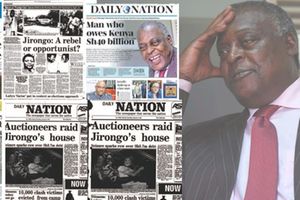Premium
Why you should visit Uhuru Park if you haven’t done so yet

Kenyans make their way to Uhuru Park, which remained open on Christmas Day. Hundreds of families spent the day at the redesigned park.
Christmas and on Tuesday, so we have been informed by City Hall staff, Uhuru Park will be open to the public again for the two days – with no gate charges.
A previous announcement had it that it would be open immediately after the second edition of the six-day Nairobi Festival finished on December 17 – where we were promised that the vibrant pulse of the city would come to life.
And so it did. As well as a varied programme of live music, stalls were exhibiting local crafts, workshops on art and a children’s play area. If you were not there, you can get a flavour of it by watching a rather raucous presentation on YouTube.
I used to keep well clear of Uhuru Park. It had a rather unsavoury reputation. It was thought to be a hunting ground for conmen and pickpockets, as well as hawkers and street boys. But there have been some remarkable events there – and one particular threat to its existence.
Most Kenyans will know about two protest occasions. One of them was when a couple of Kenyan mothers shamed the police at what is now called the Freedom Corner of the park.
It was in February 1992, when the Mothers of Political Prisoners petitioned for the release of their sons. When no action was taken, they gathered in the park and started a hunger strike.
Freedom Corner
When the police tried to disperse them with batons, tear gas and shots in the air, two of the mothers stripped in front of them and the police retreated.
Prof Wangari Maathai had supported the mothers’ protest. Two years before that, she had led a popular campaign against the construction of a 60-storey Kenya Times Media Trust Complex in the park.
Whether it was eventually stopped because of the protest or because the key foreign investor got himself into serious financial trouble, we can’t be sure.
But, if it hadn’t been stopped, the park would have lost far more than the small portion recently taken for the construction of the Nairobi Expressway.
The foreign investor was the British publishing tycoon, Robert Maxwell, owner of Pergamon Press and the umbrella company, Maxwell Communications. Because he was born in Czechoslovakia and because he had a reputation for doing dodgy financial deals, he was known by some journalists as the ‘Bouncing Czech’.
Paved walkways
The deal he did in Kenya was that his Maxwell Communications would have a 45 per cent stake in the Kenya Times Media Trust, with KANU Investments Ltd holding 55 per cent. The aim was to make the Kenya Times the leading newspaper in East Africa – and to build the tallest building in the whole of Africa.
Three British journalists were imported by the Kenya Times – one of them became the Editor. A foreign advisory editor of the Nation told me about an amusing conversation he had had with the new Editor of the Kenya Times.
‘That cockerel’, the Editor said, ‘It will have to go.’ ’But it’s the KANU symbol,’ my friend said. ‘It doesn’t matter. It will have to go,’ the Editor insisted, saying he had had a meeting with President Moi. He asked if he could get him off the front page occasionally. President Moi’s answer was, ‘Yes, if you have a better story.’ The Editor didn’t last long.
Anyway, if you can go along to Uhuru Park now it is open again, you will see less grandiose but more appropriate constructions than the proposed skyscraper.
Once through the imposing gates, the paved walkways will lead you past fountains, hardwood benches and sculptured animals; they will lead you to a huge skeleton of an aeroplane, a cleaned-up lake and an amphitheatre with a massive audio-visual screen.
The old cockerel that was there – the symbolic bird that so bothered the imported Kenya Times Editor – is now a golden one.





